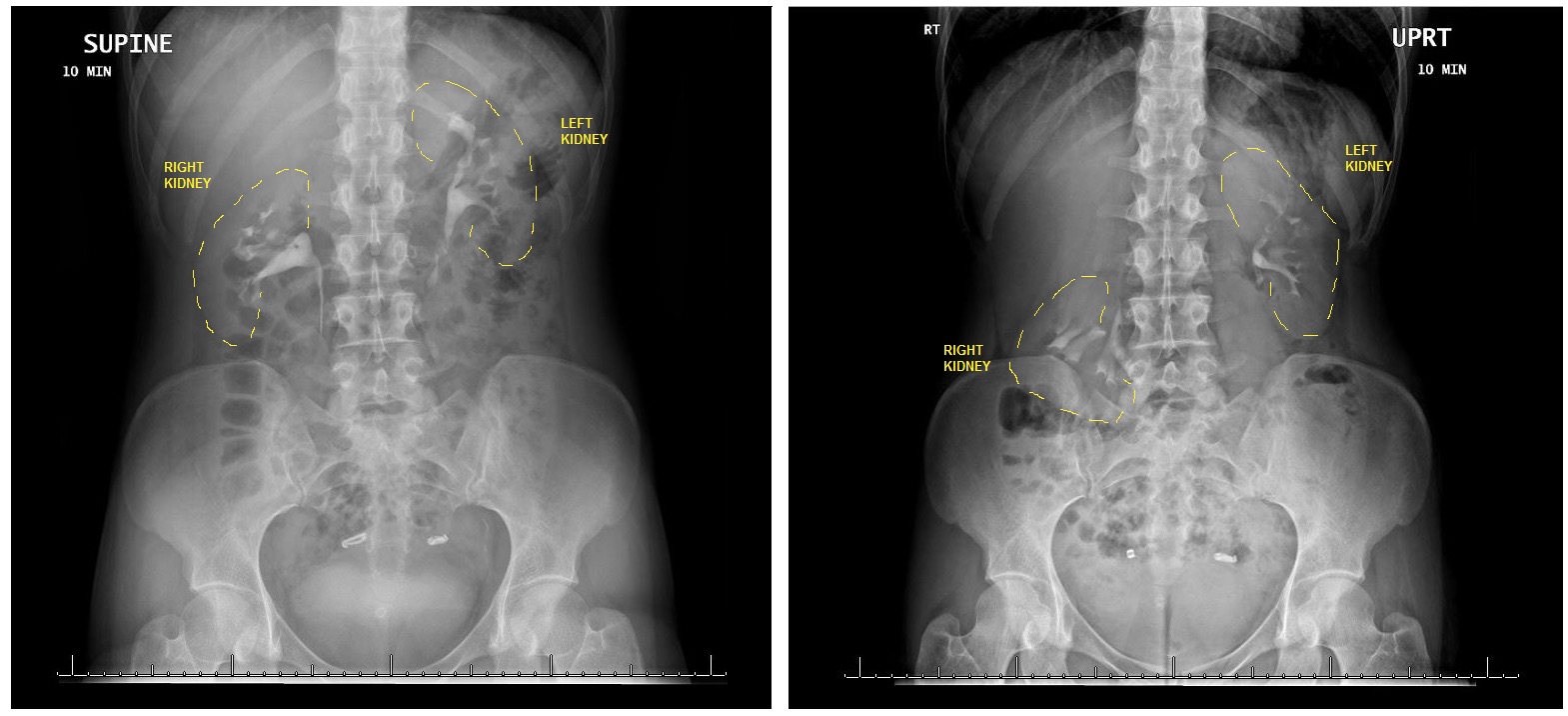This Woman's Kidney Fell into Her Pelvis Whenever She Stood Up: Here's Why

In the scan on the right, taken when the woman was standing upright, her right kidney (seen on the left in the scan) falls into the pelvis. The left kidney (seen on the right in the scan) can be seen just below the ribs.
This image was modified by Dr. Sood to clearly show the kidneys. (Image credit: Akshay Sood/BMJ Case Reports 2018)
Generally, you can trust your organs to stay in one place. Sure, they may puff up with air or constrict to pump blood, but they do so in the same location in your body.
That wasn't the case for a young woman in Michigan, however, who told doctors she felt like "a ball was rolling inside of her" when she would go from lying down to standing up. The "ball," it turned out, was her right kidney.
According to a new report of her case, the 28-year-old woman had a rare condition known as a floating kidney. For nearly six years, she had experienced abdominal pain on her right side that felt worse when she was standing but better when she was lying down. She also told doctors that the pain was reduced toward the end of a recent pregnancy. [27 Oddest Medical Cases]
A floating or "wandering" kidney (known medically as "nephroptosis") is a condition in which one of the kidneys falls into the pelvis when a person stands up, said case report author Dr. Akshay Sood, a urologist at Henry Ford Hospital in Detroit who treated the woman. In the woman's case, her right kidney fell more than 2 inches (almost 6 centimeters) down, or the length of two vertebrae, when she shifted positions from lying down to standing up, he said.
The reason some people have a floating kidney has to do with body fat. Ordinarily, the kidneys have a lot of fat around them to support them, Sood told Live Science. But sometimes, especially in thin women, there isn't enough fat to keep the kidney in place, so it falls into the pelvis when a person stands up due to gravity, he said.
When this happens, it causes a hooking or kinking of the blood vessels attached to the organ, and it also causes a bend in the ureter, a duct that passes urine from the kidney to the bladder, Sood said. Because of this bend in the ureter, it can't drain urine properly. As a result, urine flows back into the kidney and collects there, which can cause the kidney to swell up like a balloon and can lead to pain, he said.
Hard to diagnose
"A floating kidney is a hard condition to diagnose, and it's not that common," Sood said.
Sign up for the Live Science daily newsletter now
Get the world’s most fascinating discoveries delivered straight to your inbox.
One reason it could be hard to detect the condition is that, if a CT scan is done, this scan is taken while the person is lying down, so the kidneys would look like they were in a normal position in the body, Sood said; therefore, doctors might not suspect that something is wrong. For the woman in this case, her problems and pain occurred only when she was standing, he added.
The woman didn't have pain when she was reclining because her kidney stayed in its normal position, and she also felt better in late pregnancy because her larger uterus provided support from below for the kidney, so it would not move down into her pelvis, Sood explained.
Another reason that some doctors might not have made the proper diagnosis in this case is that there has also been some controversy surrounding the diagnosis of a floating kidney, Sood said. About 20 to 30 years ago, floating kidney was overdiagnosed and overtreated in patients; as a result, some institutions emphasized the condtion less in medical training. That means that some urologists may have little knowledge of it, he said.
When scans were finally taken of the woman's kidneys in both a lying-down and upright position, the images showed that her right kidney had migrated downward toward her pelvis when she stood up. This confirmed the diagnosis of a floating kidney, Sood said.
To treat the problem and eliminate the woman's pain, doctors needed to do an operation known as a "nephropexy." In this procedure, doctors made small incisions in her abdomen and put stitches into the capsule of the kidney, which covers its outer surface, and tied it to the back wall of her body, Sood said. This holds the kidney in place and prevents it from flopping down, he said.
Since having the surgery, the woman no longer has symptoms or pain, and she has been doing fine, Sood said.
The case report was published April 17 in the journal BMJ Case Reports.
Originally published on Live Science.
Cari Nierenberg has been writing about health and wellness topics for online news outlets and print publications for more than two decades. Her work has been published by Live Science, The Washington Post, WebMD, Scientific American, among others. She has a Bachelor of Science degree in nutrition from Cornell University and a Master of Science degree in Nutrition and Communication from Boston University.










